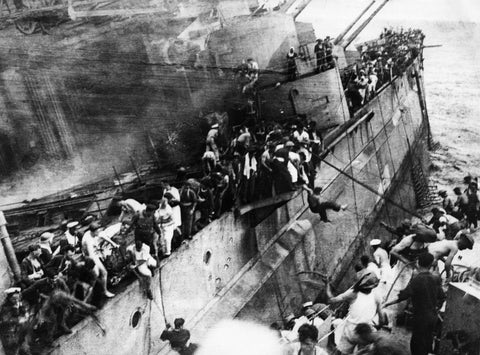
Chinese Ship Accused of Looting Iconic WWII Wrecks
An illegal Chinese salvage operation is suspected to have raided two iconic World War II wrecks, USNI first reported.
Malaysian authorities discovered scrap steel, aluminum and brass fittings aboard the Chinese cargo ship Chuan Hong 68. The ship was boarded and searched after __ Malaysian authorities found that the ship was not authorized to anchor in the waters under Malaysian jurisdiction, according to CNN.
The British ships, HMS Prince of Wales and the HMS Repulse, are designated war graves, with Professor Dominic Tweddle, Director General of The National Museum of the Royal Navy, writing in a statement:
“We are distressed and concerned at the apparent vandalism for personal profit of HMS Prince of Wales and HMS Repulse… We are upset at the loss of naval heritage and the impact this has on the understanding of our Royal Navy history.”
Sunk just three days after the attack on Pearl Harbor, on Dec. 10, 1941, the Royal Navy ships were attacked and, having no aerial defense, sunk by Imperial Japanese Navy aircraft. The strike killed some 842 sailors and is considered one of the worst disasters in British naval history.
The loss shocked the nation, forcing the navy to re-evaluate how it had fought for centuries — moving it away from the Mahanian notion that “Big ships with big guns, concentrated into a single, undivided battle fleet, and infused with an overriding purpose to wipe the enemy off the face of the sea” was the way to rule the waves, writes Ian Toll in “The Pacific Crucible”.
Carrier strike groups were in. Antiquated battleship tactics were out.
Of the loss, Prime Minister Winston Churchill recalled in his postwar memoirs:
“In all the war, I never received a more direct shock… As I turned over and twisted in bed the full horror of the news sank in upon me. There were no British or American ships in the Indian Ocean or the Pacific except the American survivors of Pearl Harbour, who were hastening back to California. Across this vast expanse of waters, Japan was supreme, and we everywhere were weak and naked.”
Today, the battleship HMS Prince of Wales rests upside down 223 feet underwater near Kuantan in the South China Sea. The battlecruiser HMS Repulse lies several miles away from its sister ship.
The Chinese looting sparked outrage and concern from both the British and their American, Dutch and Australian allies.
According to USNI News, the looting has become common in the past several years, with more than 40 Australian, Dutch and Japanese warships and merchantmen in the same waters off Indonesia and Singapore already destroyed.
Old shipwrecks are increasingly targeted by scavengers “for their rare low- background steel, also known as ‘pre-war steel’. The low radiation in the steel makes it a rare and valuable resource for use in medical and scientific equipment,” writes the BBC.
For the United States, the U.S. Navy has expressed concern over the safety of cruiser the USS Houston, which was sunk just south of the same area during the Battle of Sunda Strait on March 1, 1942. More than 650 U.S. sailors and Marines died when the Houston sank.
While the wrecks remain a key part of World War II history, most importantly, they are the watery gravesites for sailors and Marines alike entombed within.
“A strategy is vital to determine how to assess and manage these wrecks in the most efficient and effective manner,” Tweddle stated. “Above all, we must remember the crews who served on these lost ships and all too often gave their lives in the service of their country.”
historynet magazines
Our 9 best-selling history titles feature in-depth storytelling and iconic imagery to engage and inform on the people, the wars, and the events that shaped America and the world.
